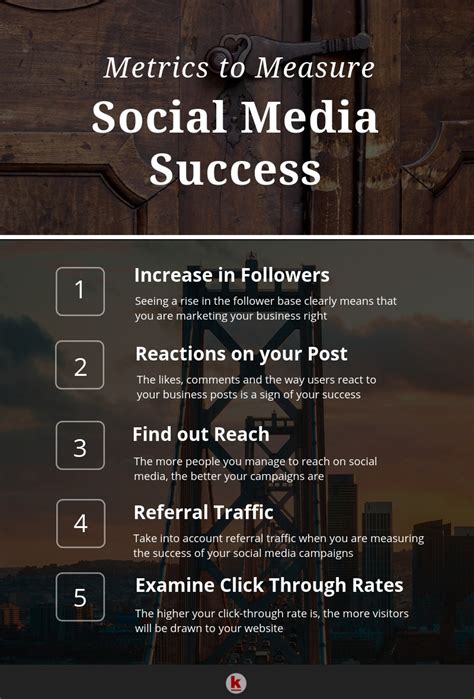Creating a strong online presence has become a crucial aspect for businesses striving to reach their target audience and generate conversions. In today's digital age, social media has emerged as a powerful tool to connect with potential customers and promote products and services. To harness the full potential of social media marketing, it is essential to implement effective strategies that can capture the attention of your audience and drive engagement. In this article, we will explore some valuable insights and techniques to maximize your impact on social media platforms.
Engage Your Audience with Compelling Content
One of the keys to success in social media marketing lies in creating content that resonates with your target audience. Instead of simply promoting your products or services, focus on addressing the needs and interests of your followers. By providing valuable and informative content, you can establish your brand as a reliable source of information, earning the trust and loyalty of your audience. Consider incorporating visual elements, such as eye-catching images or videos, to make your content more engaging and shareable.
Utilize Influencer Partnerships to Expand Your Reach
Influencers play a significant role in shaping the online behavior of their followers. Collaborating with influencers who align with your brand values and target audience can significantly boost your social media marketing efforts. By leveraging their reach and credibility, you can tap into new markets, increase brand awareness, and drive traffic to your website or online store. To ensure a successful partnership, it is crucial to carefully choose influencers who genuinely resonate with your brand and whose followers are likely to be interested in your products or services.
Analyze and Optimize Your Social Media Campaigns
Successful social media marketing relies on data-driven insights and continuous optimization. Take advantage of the analytics tools provided by various social media platforms to gauge the performance of your campaigns. Analyze metrics such as engagement rate, click-through rate, and conversion rate to understand what strategies work best for your target audience. Experiment with different types of content, posting schedules, and advertising campaigns to identify the most effective approaches. By regularly monitoring and tweaking your social media campaigns, you can maximize your return on investment and consistently enhance your online presence.
Defining Your Target Audience and Setting Clear Goals

Understanding your target audience and setting clear goals are critical components of a successful social media marketing strategy. By clearly identifying who your audience is and what you want to achieve, you can tailor your content and campaigns to reach the right people and achieve desired results.
When defining your target audience, it's important to consider factors such as demographics, interests, and behaviors. By understanding who your audience is, you can create content that resonates with them and meets their specific needs and desires.
Setting clear goals is equally important. Whether you want to increase brand awareness, drive website traffic, generate leads, or boost sales, having well-defined goals allows you to measure the success of your social media marketing efforts. Goals should be specific, measurable, achievable, relevant, and time-bound (SMART). This ensures that you have a clear direction and can track your progress along the way.
Once you have defined your target audience and set clear goals, you can develop a social media strategy that aligns with these factors. This includes selecting the most appropriate social media platforms to reach your audience, creating engaging content, and implementing effective tactics to achieve your goals.
Regularly analyzing and evaluating the performance of your social media marketing efforts is crucial. By monitoring key metrics and adjusting your strategy accordingly, you can optimize your campaigns and ensure that you are effectively reaching and engaging your target audience.
- Identify your target audience based on demographics, interests, and behaviors
- Set specific, measurable, achievable, relevant, and time-bound goals
- Create content and campaigns that resonate with your audience
- Select the most appropriate social media platforms
- Analyze and evaluate the performance of your social media marketing efforts regularly
By defining your target audience and setting clear goals, you can develop and implement effective social media marketing strategies that deliver tangible results for your business or brand.
Create Compelling and Shareable Content
Engaging your audience and encouraging them to share your content on social media platforms is crucial for any successful marketing strategy. In this section, we will explore various techniques to create content that captivates your target audience and motivates them to share it with their own networks.
To grab the attention of your audience, it is important to understand their interests and preferences. By conducting market research, studying relevant trends, and analyzing your target audience's behavior on social media, you can gain valuable insights into what content will resonate the most with them. This knowledge will enable you to create content that is tailored to their needs, increasing the likelihood of engagement and sharing.
When creating content, consider incorporating innovative and thought-provoking ideas that provide unique perspectives or solve common problems. By offering valuable information or entertainment in a fresh and engaging way, you can capture the interest of your audience and make your content more shareable.
Visual elements play a crucial role in capturing attention and driving engagement on social media. Integrating eye-catching images, infographics, or videos into your content can make it more visually appealing and memorable. Additionally, using relevant and descriptive captions, titles, and hashtags can further enhance the shareability of your content by making it easily searchable and identifiable for your target audience.
Another effective strategy for creating engaging and shareable content is to evoke emotions. People are more likely to share content that elicits strong emotions, such as humor, awe, or sadness. By crafting content that triggers an emotional response, you can connect with your audience on a deeper level and encourage them to share it with their friends, family, or colleagues.
- Conduct market research to understand your target audience's interests and preferences.
- Incorporate innovative and thought-provoking ideas into your content.
- Utilize eye-catching visuals, captions, titles, and hashtags.
- Evoke emotions to create a deeper connection with your audience.
By implementing these strategies, you can create content that not only engages your audience but also increases its shareability, ultimately expanding your reach and amplifying the impact of your social media marketing efforts.
Utilize Various Social Media Platforms

Incorporating multiple social media platforms into your marketing strategy can greatly enhance your online presence and reach a wider audience. By diversifying your social media presence, you can adapt your content and engage with different segments of your target market effectively. Each social media platform offers unique features and tools, allowing you to create a comprehensive and compelling online presence.
Exploit Different Social Media Channels
Take advantage of the diverse range of social media channels available to promote your brand, products, and services. Platforms such as Facebook, Twitter, Instagram, LinkedIn, and Pinterest offer distinct opportunities to connect with your audience and showcase your offerings in creative ways. Varying the types of content you share across different platforms can help you cater to the preferences and behaviors of different user demographics.
Amplify Your Reach Across Platforms
Each social media platform has its own strengths and limitations. By utilizing a variety of platforms, you can amplify your reach and increase the chances of attracting and engaging with potential customers. For example, visual platforms like Instagram and Pinterest can be utilized to showcase your products or services through high-quality images. On the other hand, platforms like LinkedIn provide a professional environment for networking and sharing industry-related content.
Customize Content for Different Platforms
Recognize that each platform has its own unique user base and content format requirements. Creating content that aligns with the style and preferences of each platform ensures maximum engagement and effectiveness. Tailor your posts, images, and videos to suit the specific platform you are using, optimizing them to generate interest and encourage sharing. Customizing your content for different platforms demonstrates your adaptability and commitment to providing valuable and relevant information.
Cross-Promote Your Social Media Profiles
To maximize the impact of your social media marketing strategy, cross-promote your various social media profiles. This can be done by sharing links and handles across platforms, encouraging your audience to follow your brand on multiple channels. Cross-promotion not only increases visibility but also facilitates a seamless brand experience for your audience, ensuring they can easily connect with you on their preferred platforms.
Use Eye-catching Visuals to Grab Attention
Visual content plays a crucial role in attracting and engaging your target audience on social media platforms. In a fast-paced and visually-driven online world, using appealing visuals is a powerful way to capture attention and make your brand stand out. By incorporating eye-catching images, videos, and infographics, you can effectively convey your message and create a lasting impression.
Why visuals are important:
Visuals have the ability to convey complex ideas and emotions in a concise and memorable way. They can instantly grab attention and evoke a strong emotional response, making your content more shareable and increasing its reach. In a cluttered social media landscape, using visuals allows you to cut through the noise and make a lasting impact on your audience.
Choosing the right visuals:
The key to capturing attention with visuals is to choose ones that are relevant, high-quality, and visually appealing. They should align with your brand's message and resonate with your target audience. Experiment with different types of visuals, such as images, videos, animations, or infographics, to find out what works best for your audience and social media platform.
Optimizing visuals for social media:
When using visuals for social media marketing, it is important to optimize them for each platform. Different platforms have different image and video specifications, so make sure to resize and optimize your visuals accordingly. Additionally, consider adding captions, quotes, or overlays to make your visuals more engaging and shareable.
Using user-generated content:
Encourage your audience to create and share their own visuals related to your brand. User-generated content not only adds authenticity and credibility to your marketing efforts but also increases engagement and brand loyalty. Share and showcase user-generated visuals on your social media platforms to foster a sense of community and encourage further participation.
Incorporating compelling visuals into your social media marketing strategy will help your brand capture attention, increase engagement, and ultimately drive desired actions from your target audience. Remember to consistently analyze and measure the impact of your visuals to refine your approach and optimize your social media marketing efforts.
Engage and Interact with Your Target Audience

In order to optimize your social media marketing efforts, it's important to actively engage and interact with your target audience. By establishing meaningful connections and fostering two-way communication, you can create a loyal community of followers who are genuinely interested in your brand and its offerings.
Build Relationships: It's essential to go beyond simply broadcasting your message on social media platforms. Take the time to get to know your audience and build relationships with them. Show genuine interest in their opinions, thoughts, and concerns. By doing so, you'll earn their trust and establish a solid foundation for ongoing engagement.
Encourage Dialogue: Sparking conversations and encouraging dialogue is vital for creating an engaged community. Pose open-ended questions, seek feedback, and respond actively to comments and messages. By actively participating in conversations, you demonstrate that you value your audience's input and that their opinions matter.
Provide Value: To keep your audience engaged, it’s important to consistently provide value. Share informative and interesting content related to your industry or niche. This could include tips, insights, tutorials, or industry news. By consistently delivering valuable content, you position yourself as an expert and keep your audience interested and coming back for more.
Personalize Your Interactions: Treat your audience as individuals by personalizing your interactions as much as possible. Use their names when responding to comments, tailor your content to their needs and interests, and address any concerns they may have. This personalized approach shows that you see them as more than just numbers, but as valued members of your community.
Embrace User-Generated Content: Encourage your audience to generate and share their own content related to your brand. This could include testimonials, reviews, photos, or videos. User-generated content not only increases engagement but also acts as social proof, as it showcases real people who have had positive experiences with your brand.
In conclusion, by actively engaging and interacting with your target audience on social media, you can build meaningful relationships, foster two-way communication, and create a loyal community of followers. By providing value, personalizing your interactions, and embracing user-generated content, you'll be able to maximize the effectiveness of your social media marketing strategies.
Leveraging Influential Figures on Social Platforms
Nowadays, it has become increasingly essential for brands and businesses to tap into the power of influential individuals and their impact on social media platforms. By collaborating with these influential figures, also known as social media influencers, businesses can effectively expand their reach, enhance their brand awareness, and drive engagement with their target audience.
Identifying the Right Influencers: One of the crucial aspects of leveraging social media influencers is finding the right individuals who align with your brand values, target audience, and marketing goals. These influencers should have a genuine and engaged following, as well as a reputation for creating high-quality and relevant content that resonates with their audience.
Building Authentic Relationships: Building authentic relationships with social media influencers is key to successful collaboration. Rather than simply considering them as a means for marketing, it is important to approach influencers as partners and work towards mutual benefits. This involves engaging with their content, fostering genuine interactions, and demonstrating a genuine interest in their work.
Creating Compelling Content: Collaborating with influencers offers an excellent opportunity to create unique and compelling content that can captivate your target audience. By combining their creativity and expertise with your brand's message, you can produce content that is authentic, relevant, and engaging. This can help in building trust, increasing brand credibility, and ultimately driving conversions.
Measuring and Analyzing Results: As with any marketing strategy, it is crucial to measure the effectiveness of your influencer collaborations. By tracking key metrics such as reach, engagement, and conversions, you can determine the success of your campaigns and make informed decisions for future influencer partnerships. Utilizing analytics tools and social media insights can provide valuable data to refine your strategies and maximize your return on investment.
Staying Ethical and Transparent: It is imperative to maintain ethical practices and transparency when working with social media influencers. Clearly communicate any sponsored or promotional content, ensuring that it aligns with the regulations and guidelines set by the respective social media platforms. This fosters trust with your audience, avoids potential legal issues, and upholds the integrity of your brand.
Continuously Evolving Strategies: The landscape of social media is constantly evolving, and so should your influencer marketing strategies. Stay updated with the latest trends, algorithm changes, and shifts in consumer behavior. Regularly assess the performance of your influencer collaborations and adapt your strategies accordingly to keep your brand at the forefront of effective social media marketing.
By harnessing the potential of social media influencers, businesses can gain a competitive edge, tap into new markets, and establish a strong presence on various social platforms. Embracing collaboration with influential figures can pave the way for successful and impactful social media marketing efforts.
Monitor and Analyze Your Performance

In order to continuously improve and optimize your social media marketing efforts, it is essential to closely monitor and analyze your performance on various platforms.
Tracking and measuring the impact of your social media activities allows you to gain valuable insights into the effectiveness of your strategies. By analyzing data such as audience engagement, reach, and conversions, you can make informed decisions and adjust your approach accordingly.
Regularly monitoring your performance helps you identify any patterns or trends, allowing you to capitalize on what works and address any shortcomings. By keeping a close eye on metrics and key performance indicators, you can ensure that your efforts are aligned with your goals and objectives.
Utilize powerful analytics tools and tracking systems to gather data on important metrics such as follower growth, click-through rates, and website traffic originating from social media platforms. These insights will enable you to understand the impact of your marketing activities and make necessary refinements for better results.
Remember that monitoring and analyzing your performance is an ongoing process. It is essential to regularly review your strategy, make data-driven adjustments, and stay up-to-date with the latest industry trends and best practices to stay ahead of the competition.
Investing time and effort into monitoring and analyzing your performance on social media will undoubtedly contribute to the success of your marketing efforts and help you achieve your business objectives.
Incorporate Hashtags and Keywords
Boost the reach and impact of your social media marketing campaigns by effectively incorporating hashtags and keywords. By strategically using these powerful elements, you can enhance the visibility of your content and engage a wider audience.
1. Discovering the right hashtags:
- Identify the keywords and phrases that resonate with your brand and target audience.
- Research popular hashtags relevant to your industry and niche.
- Utilize tools and platforms to find trending hashtags and discover new ones.
- Consider creating unique branded hashtags to promote your business and encourage user-generated content.
2. Using hashtags and keywords in your posts:
- Include relevant hashtags in your social media captions and comments to categorize and group your content.
- Avoid overusing hashtags; instead, focus on quality and relevance.
- Ensure that your keywords are naturally integrated into your post's text, titles, and descriptions.
- Experiment with different hashtag and keyword combinations to maximize your organic reach.
3. Engaging with popular hashtags:
- Participate in trending conversations by using relevant hashtags in your posts.
- Monitor and engage with discussions that are happening around popular hashtags in your industry.
- Encourage your followers to use branded hashtags and share their experiences with your products or services.
- Interact with users who are using the same hashtags and keywords by liking, commenting, and sharing their content.
4. Analyzing the effectiveness of hashtags and keywords:
- Regularly monitor and track the performance of hashtags and keywords to identify their impact on your social media engagement and reach.
- Use analytics tools provided by social media platforms to understand which hashtags and keywords are driving the most traffic and engagement.
- Refine your hashtag and keyword strategies based on the insights gathered from analytics.
By incorporating relevant hashtags and keywords into your social media marketing efforts, you can optimize your content for enhanced visibility, increased engagement, and ultimately, drive better results for your brand.
Boost Your Social Media Reach by Collaborating with Fellow Brands or Influencers

In today's competitive online landscape, it is crucial to find innovative ways to expand your social media presence and engage with your target audience. One effective strategy is to collaborate with other brands or influential individuals who share similar values or target demographics. By forming partnerships and leveraging each other's strengths, you can significantly enhance your brand visibility, reach, and credibility on social media platforms.
Stay Up-to-Date with the Latest Trends and Tools in Social Media
Remaining informed about the ever-evolving landscape of social media is imperative for successful marketing campaigns. Staying up to date with the latest trends and utilizing the most effective tools allows businesses to stay competitive and engage with their target audience in meaningful ways.
Keeping abreast of the latest social media trends involves monitoring the changing preferences and behaviors of users across different platforms. By understanding what captivates and resonates with the online community, businesses can tailor their marketing strategies to align with these trends and attract attention.
Furthermore, staying informed about the tools and technologies available for social media marketing is crucial in maximizing efficiency and effectiveness. From analytics platforms to scheduling tools, there is a wide array of resources that can streamline processes and provide valuable insights into audience engagement. By incorporating these tools into their strategies, businesses can gain a competitive edge and achieve their marketing goals more efficiently.
Regularly researching and exploring emerging trends and tools in social media marketing allows businesses to adapt to the ever-changing digital landscape. As technology evolves and consumer preferences shift, keeping informed becomes an ongoing process. By embracing innovation and making use of the latest trends and tools, businesses can optimize their social media marketing strategies and connect with their audience on a deeper level.
FAQ
What are some effective social media marketing strategies?
Some effective social media marketing strategies include creating high-quality content, engaging with your audience, using hashtags, collaborating with influencers, and running paid ads.
How can I create high-quality content for social media marketing?
To create high-quality content for social media marketing, you should focus on providing value to your audience, using visually appealing images or videos, writing compelling captions, and using relevant hashtags.
Why is engaging with your audience important in social media marketing?
Engaging with your audience is important in social media marketing because it helps build a loyal community, increases brand awareness, and fosters customer loyalty. It also allows you to gather feedback and insights from your audience.
What are the benefits of collaborating with influencers in social media marketing?
Collaborating with influencers in social media marketing can help increase brand visibility, reach a wider audience, build trust with your target market, and drive more traffic and sales to your business.
How can paid ads contribute to social media marketing strategies?
Paid ads can contribute to social media marketing strategies by allowing you to target your ideal audience, increase brand exposure, drive website traffic, generate leads, and ultimately, improve your return on investment (ROI).



















